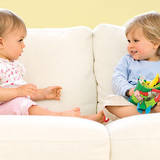Shop
01867
https://www.under5s.co.nz/shop/Hot+Topics+Articles/Child+Development/Spotting+a+left-handed+child.html
Spotting a left-handed child
|
Will your child be left-handed? What are the chances of them preferring to use their left hand over their right? Statistics show that approximately 1 in 10 people worldwide are left-handed. However there appears to be no set age as to when children show a preference over using their left hand instead of their right.
|
You might also be interested in ...
7 Tips on learning to share
Learning to share is all part of growing up, although it doesn't always come naturally with young children. Follow these tips on helping your toddler and pre-schooler learn to share and to develop friendships along the way.
Why do preschoolers lie?
Children can start lying as young as two years old. We might not like it when our kids lie to us, but believe it or not, lying in the early years is a normal part of your preschoolers development involving independence, emotional regulation and putting things into perspective. Find out more about their reasons for lying, dealing with their lies, setting an example and continued lying.
join usJoin us on social media for all our latest news. |
sign upSign up and receive our latest newsletters. |
|







Statistics show that approximately 1 in 10 people worldwide are left-handed.
However there appears to be no set age as to when children show a preference over using their left hand instead of their right.
Some 18-month-olds use one hand consistently, for others it’s not obvious until they are 3 or 4 years old.
Most children appear ambidextrous throughout their infancy and toddler years, then natural progression will eventually show which hand is going to dominate.
Spotting a left-handed child
In 2007 scientist Clyde Francks carried out research and found that a gene (LRRTM1) on the father’s side was a major contributor to left-handedness.
However if both parents are left-handed, there's a good chance that 50% of their children will be left-handed too.
But if neither parent is a lefty, the probability shrinks to only 2%.
Signs your child could be left-handed
Signs that your child might be left-handed include:
Supporting a left-handed child
For the most part, being left-handed shouldn't cause any major problems in your child's everyday life.
Being a lefty is not a negative thing, but the world tends to lend itself more to right-handed people as they are in the majority.
If you think your child could be left-handed there are some simple ways to help smooth the path for them:
More kids articles to enjoy:
- Encouraging your preschooler to read and write
- School readiness at home
- Speech development in preschool children
Image source: erinphil.blogspot.com